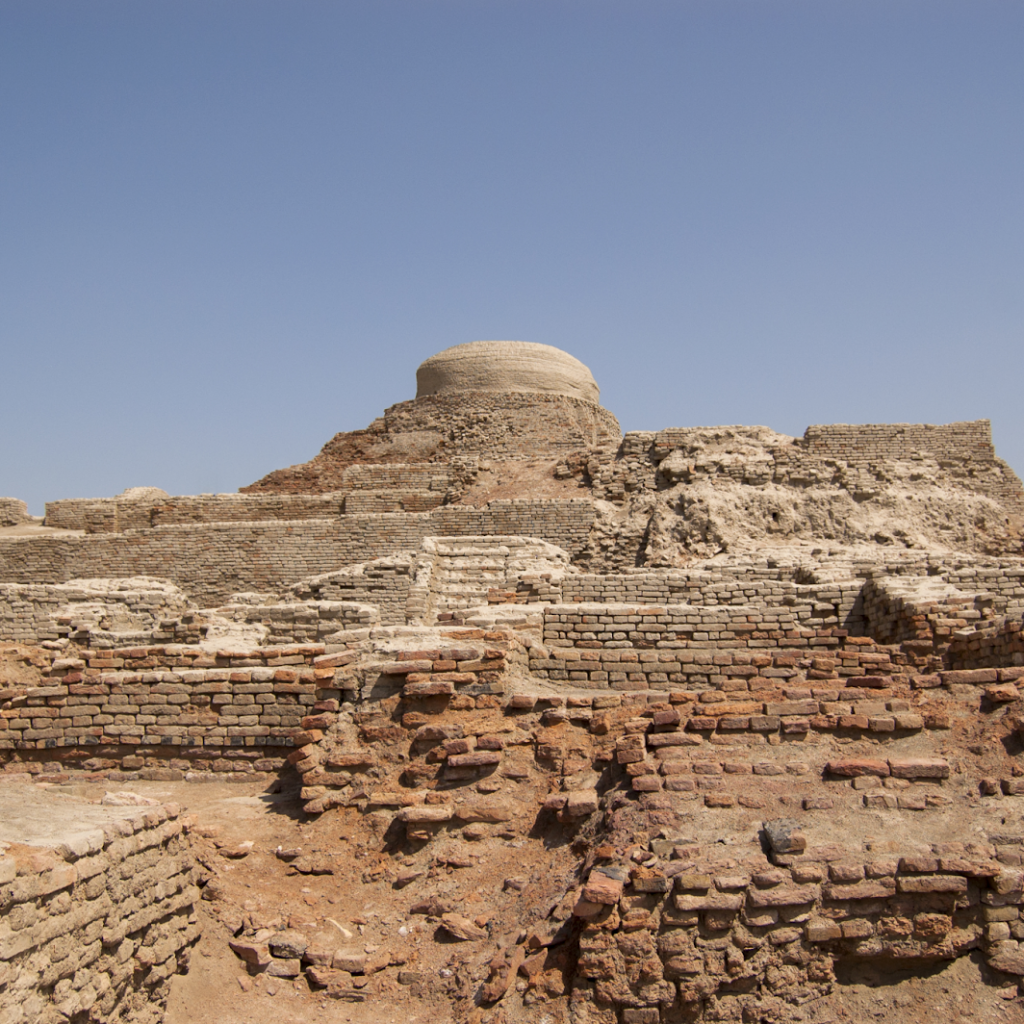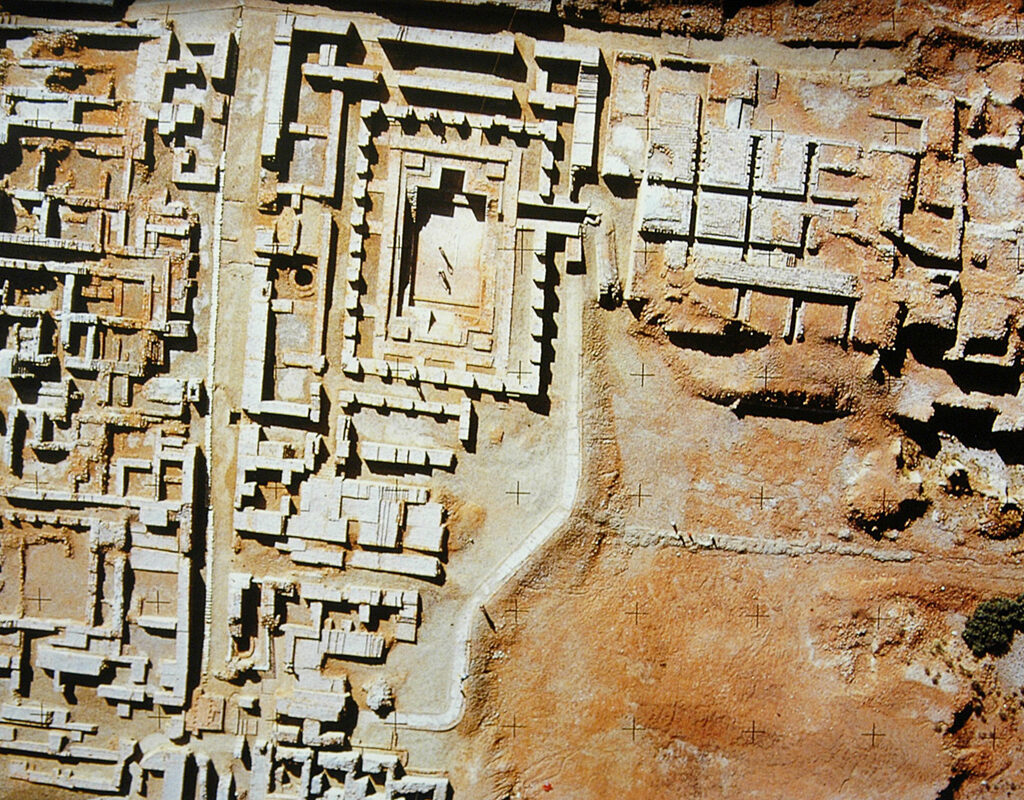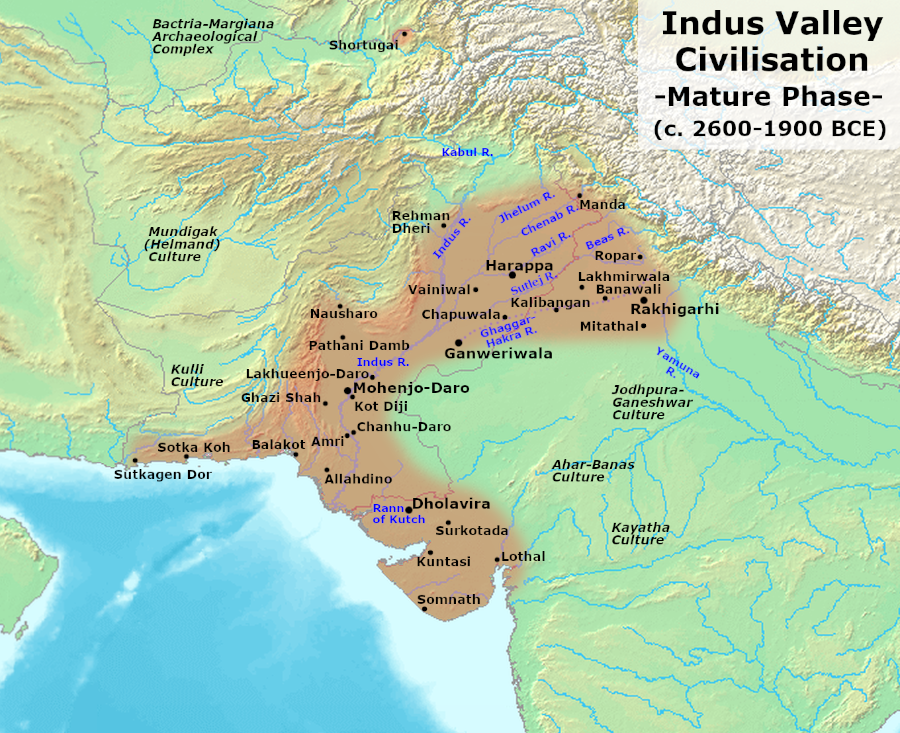The earliest known culture of the Indian subcontinent is the Indus Valley Civilization, which developed primarily during the Chalcolithic period (3300-1300 BCE). Most of the sites belonging to this period have been excavated from modern-day India and Pakistan.
The Indus Valley Civilization had two great cities, Harappa and Mohenjodaro, which emerged around 2600 BCE along the Indus River Valley in the Sindh and Punjab provinces of Pakistan. The discovery and excavation of these cities in the 19th and 20th centuries provided important archaeological data regarding the civilization’s architecture, technology, art, trade, transportation, writing, and religion.

Other important archaeological sites belonging to this period include Kot Diji in Sind, Kalibangan in Rajasthan, Rupar in the Punjab, Banawali in Haryana, and Lothal, Surkotada, and Dholavira, all three in Gujarat. Among the excavated sites, Rakhigarhi, a village located in Haryana, is the largest Indus Valley Civilization site.

Previously, Mehargarh in the Pakistani province of Baluchistan, dating from around 7000 B.C.E., was considered the oldest Indus Valley Civilization site. However, Bhirrana is now considered the oldest discovered site, with some of the oldest mounds dating back to 7500 B.C.E.
The architecture of the Indus Valley Civilization was indigenous and developed without any apparent foreign influence. The buildings were constructed purely from a utilitarian perspective rather than for aesthetic purposes. However, the architectural practices evolved from local cultures that had roots extending back thousands of years to the earliest farming and pastoral communities. The crowning jewel of the Indus Valley Civilization’s architecture happens to be the sophistication achieved with its town planning, with no other contemporary civilization able to boast such sophistication.
The town planning of Harappan cities was not uniform, but a similar pattern was followed in most of them. The fortification wall, the citadel and lower town, streets and lanes, drainage system, and water management system were the important features of Harappan city plans. The city plan was designed by the architects with the help of geometrical tools.

The Harappans were the first to prioritize the welfare of workers by establishing separate worker’s quarters, which has now become a necessity in a welfare state. The fortification was a common feature across the sites, primarily constructed to provide security to the citizens from any attacks.
Harappan cities were composed of walled sectors in different parts of the settlement. The citadel was built on a raised platform, while the lower town was located on the lower part of the town. Public buildings, like the Great Bath, were built in the citadel, while the lower town usually had only residential buildings. Some of the metropolitan cities, like Harappa, Mohenjodaro, Kalibangan, Banawali, Rakhigarhi, Lothal, and Dholavira, had citadels and lower towns, but most of the cities’ settlements were not divided into citadels and lower towns.


The Harappan people made their houses on platforms to prevent flooding, and they were masters of hydraulic engineering, developing an efficient drainage system. The Harappans used a grid pattern in their city planning, and the drops at regular intervals were constructed in the drains for self-cleaning. Soakage jars, man-hole cesspools, and other components were important in the drainage system. The construction of reservoirs was also a notable feature of the Indus Valley Civilization.

Contents
- 1 Features of Architecture of Indus Valley Civilisation
- 2 Prelims PYQ Questions
- 3 Mains PYQ Questions
- 4 FAQs
- 4.1 Q: What are the significance and purpose of the seals found in the Indus Valley Civilization?
- 4.2 Q: How were cities in the Indus Valley Civilization planned and structured?
- 4.3 Q: What is known about the script of the Indus Valley Civilization, and why is it so challenging to decipher?
- 4.4 Q: When did the Indus Valley Civilization exist, and what is its approximate time period?
- 4.5 For Admissions, talk to our Mentor – 9811333901, 9811333782
Features of Architecture of Indus Valley Civilisation
Urban Planning and Layout:
One of the remarkable aspects of the Indus Valley Civilization was its well-planned cities. Mohenjo-Daro, is renowned for its grid-like layout with wide streets, well-organized neighborhood’s, and an advanced drainage system. The meticulous planning of these cities reveals a deep understanding of urban architecture.
Brick Architecture:
The Indus Valley Civilization is credited with pioneering the use of fired bricks in construction. These bricks were uniformly sized and shaped, facilitating precise construction. The Great Bath at Mohenjo-Daro stands is an example of brick architecture. This massive structure, constructed using standardized fired bricks, showcases the precision and expertise of the Harappans in working with bricks.
Advanced Drainage System:
The advanced drainage system of the Indus Valley cities remains an architectural marvel. It consisted of covered drains and underground sewage systems that efficiently managed wastewater and maintained hygiene in urban areas.
Religious Architecture:
The discovery of structures like the Great Granary and the Great Bath suggests that these buildings might have had religious or ritualistic purposes. The Great Bath, in particular, is speculated to have been a site for purification ceremonies or communal rituals.
Decorative Elements:
Intricately designed pottery, seals, and sculptures with motifs of animals, plants, and human figures have been discovered. These decorative elements indicate a level of artistic sensibility and creativity within the civilization. For Example: Numerous artifacts, such as the famous “Dancing Girl” figurine found at Mohenjo-Daro, exemplify the decorative artistry of the Harappans.
Prelims PYQ Questions
PRELIMS- 2021
Q. Which one of the following ancient towns is well-known for its elaborate system of water harvesting and management by building a series of dams and channelizing water into connected reservoirs?
A. Dholavira
B. Kalibangan
C. Rakhigarhi
D. Ropar
Answer: D
PRELIMS- 2019
Q. Which one of the following is not a Harappan site?
A. Chanhudaro
B. Kot Diji
C. Sohgaura
D. Desalpur
Answer: C
Mains PYQ Questions
Q. The ancient civilization in the Indian sub-continent differed from those of Egypt, Mesopotamia, and Greece in that its culture and traditions have been preserved without a breakdown to the present day. Comment. (2015)
Q. To what extent has the urban planning and culture of the Indus Valley Civilization provided inputs to present-day urbanization? Discuss. (2014)
FAQs
Q: What are the significance and purpose of the seals found in the Indus Valley Civilization?
A: The seals from the Indus Valley Civilization are small, intricately carved artifacts made of various materials. They are believed to have had multiple purposes, including trade, ownership, and possibly religious or administrative functions.
Q: How were cities in the Indus Valley Civilization planned and structured?
A: Indus Valley cities were known for their impressive urban planning. They featured a grid-like layout with well-organized streets, drainage systems, and buildings made of standardized bricks. The cities, such as Mohenjo-Daro and Harappa, had residential and commercial areas.
Q: What is known about the script of the Indus Valley Civilization, and why is it so challenging to decipher?
A: The Indus script is a writing system used by the civilization, but it remains undeciphered due to the lack of a bilingual inscription or a Rosetta Stone-like discovery. It is challenging to decipher because the script is relatively short, with a limited number of characters, and the script’s symbols may have multiple meanings.
Q: When did the Indus Valley Civilization exist, and what is its approximate time period?
A: The Indus Valley Civilization, also known as the Harappan Civilization, is believed to have thrived from approximately 3300 BCE to 1300 BCE. It is one of the world’s oldest urban civilizations and predates many other ancient civilizations.

For UPSC Prelims Resources, Click here
For Daily Updates and Study Material:
Join our Telegram Channel – Edukemy for IAS
- 1. Learn through Videos – here
- 2. Be Exam Ready by Practicing Daily MCQs – here
- 3. Daily Newsletter – Get all your Current Affairs Covered – here
- 4. Mains Answer Writing Practice – here
Visit our YouTube Channel – here

